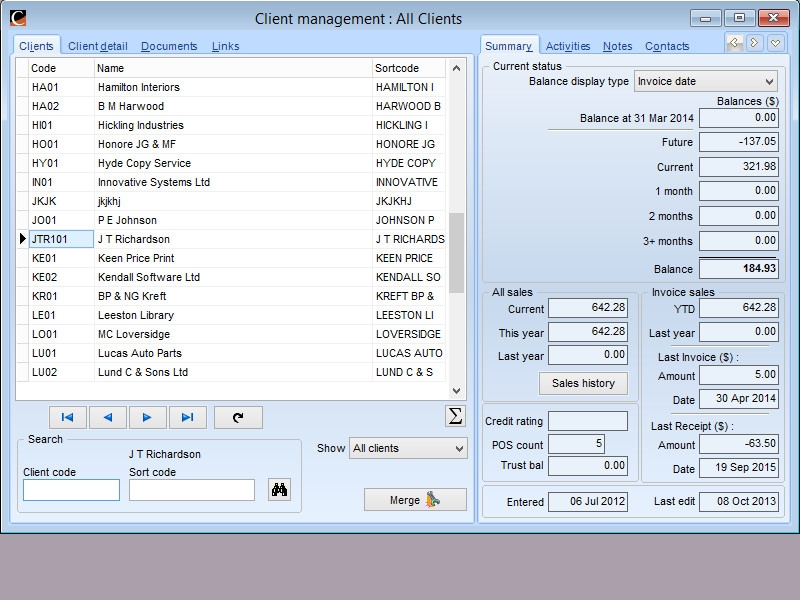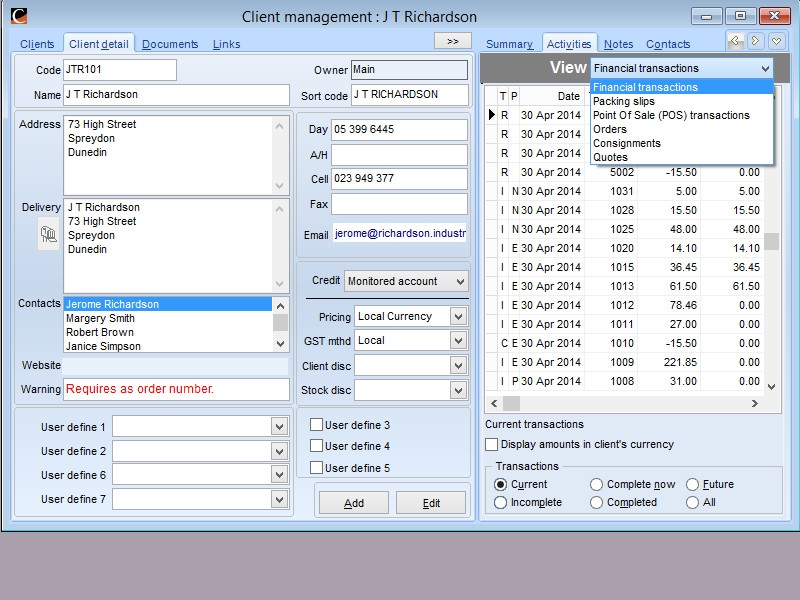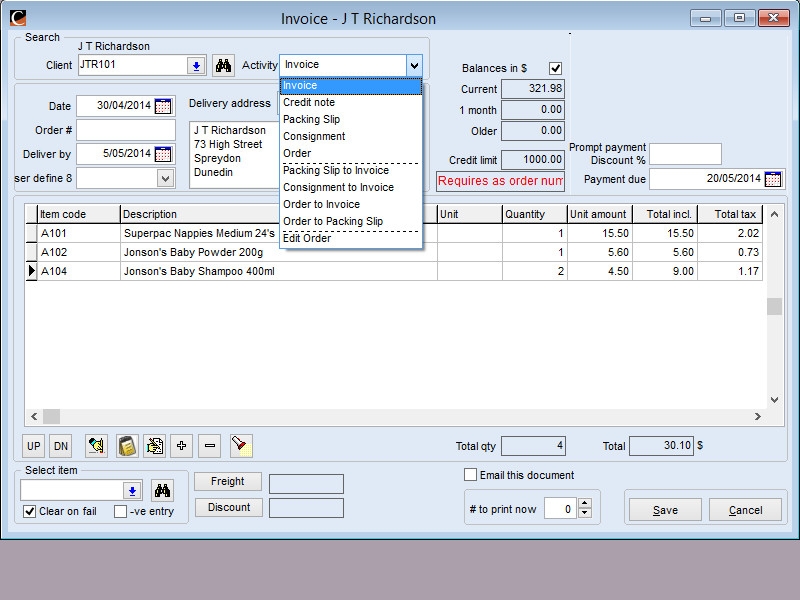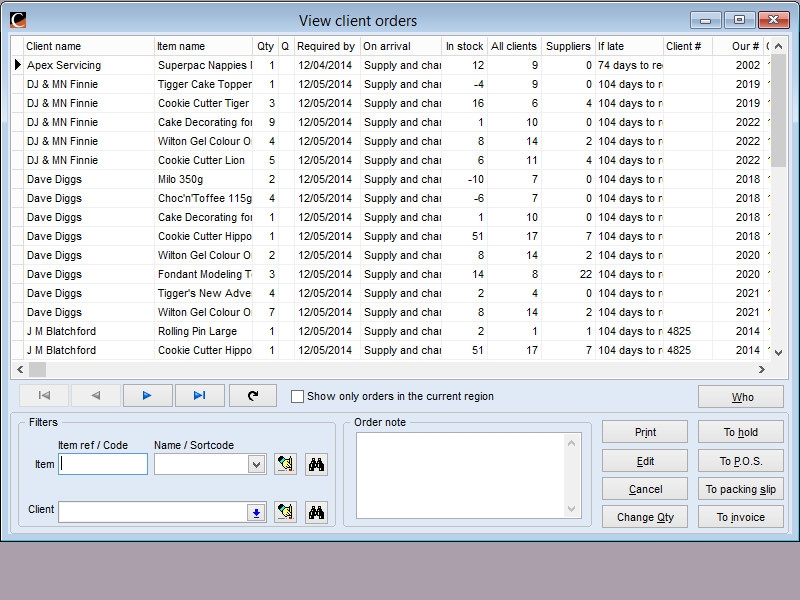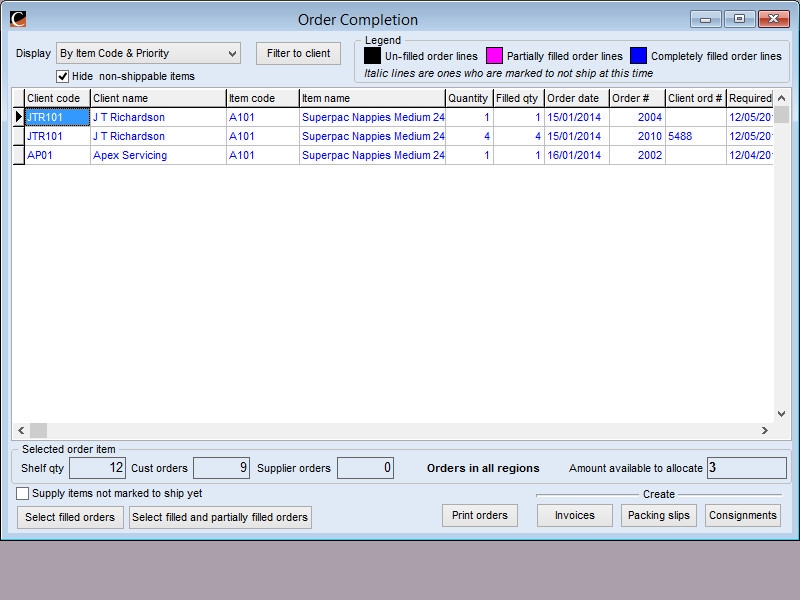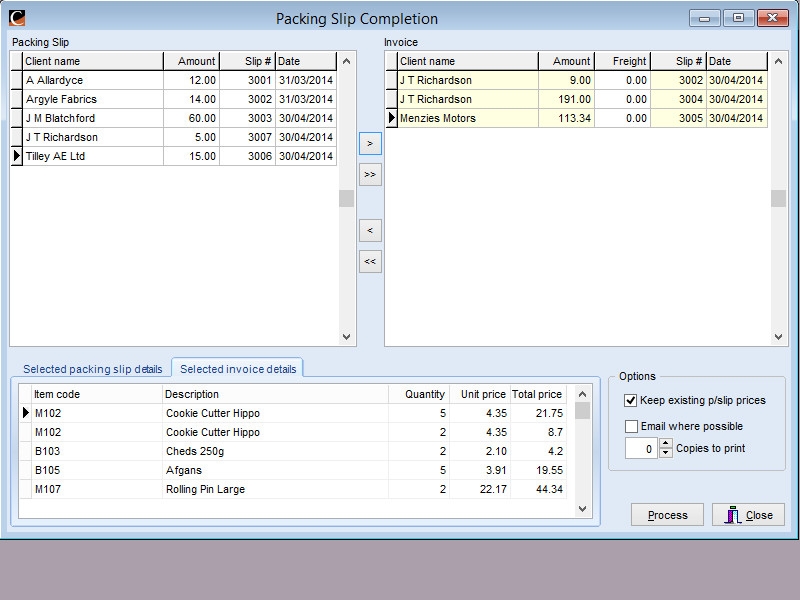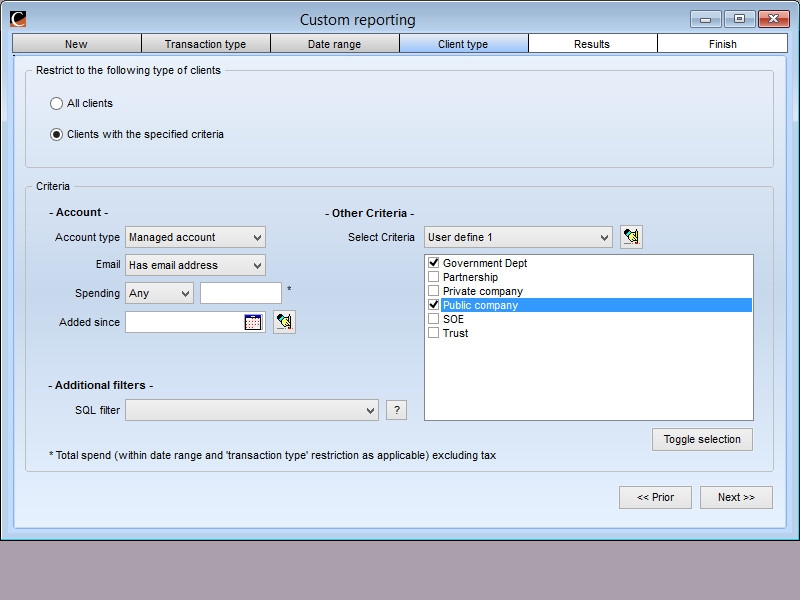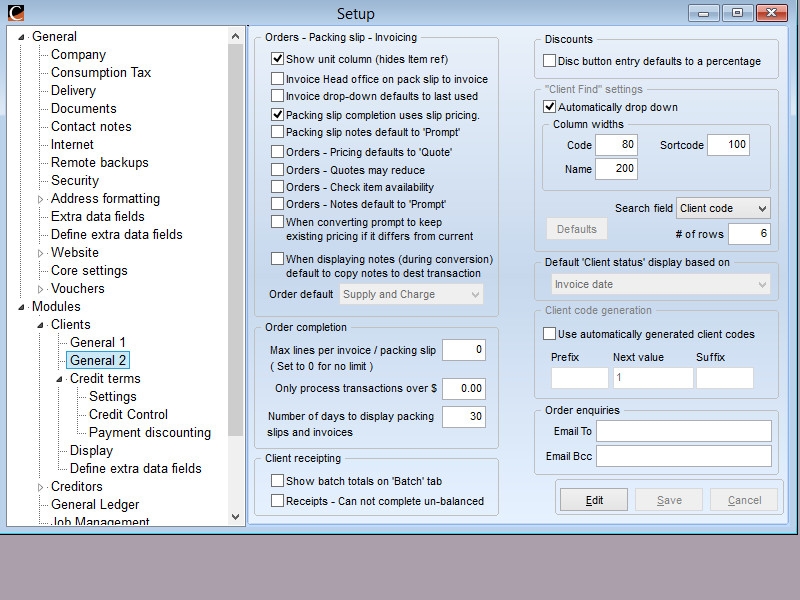Relationships are very important and by their nature each one is unique therefore, man aging your clients effectively is good business. Chreos offers many features in the Clients module that enables you to efficiently keep track of your client data.
Transactions are all entered in a step-by-step process that is consistent throughout Chreos, making it simple to apply knowledge learnt in Clients to other modules in Chreos.
Fast and easy access to current and historic data is essential in the workplace of modern business. Chreos caters for this by providing a full and concise record of current and historic client transactions.
Unique features such as profiles, recurring invoices and trust accounts make Chreos really special.
Key points(Click to expand)
Know who owes you what
Keep accurate records of what you have charged out, and when it should be paid.
Track the credit worthiness of each debtor over the last 12 months.
Track spending patterns
See who buys what from you - since you started using Chreos. Identify spending and payment patterns to facilitate marketing to people's interests 0 right from within Chreos.
See the changing patterns with a debtor or across debtors.
See who only buys when products are on special, who responds to promotions, and who buys related products - and who does not.
Debtors vs Clients
In Chreos all Debtors are a sub-set of all your clients. Clients who aren't debtors by only purchase through Point of Sales, via the web or via some other relationship.
Orders have accurace availability data
Chreos knows the availability of all products and when replacement stock is likely to arrive. It also knows what priority this order has over all other orders for the same product so it can forecast likely delivery dates.
Back orders are orders scheduled for a future date or are currently delayed. They do not get treated differently because of this. The priority is on shipping product the clients want.
Limited data entry = accurate data
- Orders can be imported from the web or from other sources. They can also be manually entered by your staff.
- Convert the order to invoice (or packing slip or picking list and then invoice) to reflect what has been supplied.
- Stock levels are automatically adjusted, GL financials are updated.
All done without having to re-enter or duplicate data.
Store all that you know
Chreos Debtors comes with a range of standard fields to store descriptive data about each debtor. In addition you can customise each record extensively:
- Record core data and contact details about everyone you deal with.
- Customise seven special fields on the front page.
- Set up an unlimited number of fields on an extra tab page. These can include look-ups, tick boxes, dates, numbers, long and short text, web links, documents, and images.
- Profiles give you a many to many relationship that provides an additional way of categorising debtors and contacting them as a group.
- An unlimited number of notes with each debtor, plus individual notes with each Order, Packing slip, consignment and financial transaction.
Automatically control credit
Have Chreos manage debtor credit based on amount owing or amount or length of time overdue. Or choose to manage some clients manually, or not give them credit at all.
Multiple pricing and discount options
Set up
- discount grid,
- multiple product, multiple quantity discount stock bins
- customised pricing for selected clients
- pricing in multiple currencies
- time determined special prices
or manually enter prices with orders. You have the control.
Market to your clients with focus
Use advanced tools to filter the data based on what they buy, how much the spend, when the buy, or a host of other options and then directly email market to them in a totally customised way.
Features(Click to expand)
Automatically maintain links between debtors and products
Each sale permanently associates a product with the purchaser. Use this information to market related products to the purchaser whether it be replacement blades for a lawn-eater, books by the same author or new versions of a cell phone.
Accurate costings and margins
Each sale of a product carries with it the cost that applied at the time of the sale and the normal sale price. This allows margins received and discounts given to be determined - even years after the event.
Always have access to the full history of the cost of a product.
Process foreign currency invoices
With the extra "Foreign currency" module Chreos allows you to work in multiple currencies. Produce each invoice in the currency assigned to the Debtors and leave Chreos to work out the local cost of products and services.
Receipt in either the Debtor's currency or your local one.
Updates account balances instantly
All debtor balances are updated immediately a transaction is processed. No delays. No over-night refreshing. The balances you see reflect what has been entered.
Summarised data posted to GL
All transaction data posts to the GL as summarised or detailed as you require.
Regardless of how it is posted you can always move between a GL journal and the Debtor entry in either direction to analyse what has happened.
Extensive search engine
Search for the debtor by code, part of name, address or phone fragment or other descriptive fields.
Search for transactions by reference number or amount.
Open item accounts
Debtors can have either open item or balance forward accounts. They can be moved between the two types as need arises.
Some functionality such as prompt payment discounts and web payment of individual invoices requires the Debtor to be set as Open item.
Recurring invoices
Set them up for individuals or for groups. Have then generate monthly yearly or with some other frequency. Have then generate automatically or need human intervention.
Track serial numbers
Serial number tracking is a standard feature of Chreos and Debtors is totally integrated to handle this tracking. Sell a tracked item by selecting which of the pre-entered serial numbers is being supplied. Accept the item back for credit by identifying the number from amoung those that have been sold.
Transactions(Click to expand)
Client orders
Orders from clients can be entered in a multitude of ways and include delivery requirements and pricing expectations.
Packing slips
Packing slips are an optional stage. If used there are several options for how product moves from order to packing slip. A packing slip has have lines from several orders, and in tern, several packing slips can be combined into one invoice.
Picking lists
Picking lists are an optional stage. If used there are several options for how product moves from order to picking list. A packing slip has have lines from several orders, and in tern, several picking list can be combined into one invoice.
Note that you can have packing slips OR picking lists but not both. The difference is in the reports produced and the use made of them.
Consignments
Consignments are when goods are supplied on a sale or return basis and you retain ownership of the goods until they are invoiced.
Invoices can be generated based on identifying what has been retained, or by charging for everything that has not been returned.
Invoices
All the above lead to invoices. Invoices can be a single items with hundreds of lines of description, or hundreds of items, or some combination of the above.
Preconfigured discounting or custom pricing automatically triggers.
Receipts
Debtor receipts can be entered singly or as a batch. There is also provision for mass receipting for Direct debits and Credit card payments.
If the Debtor is open item then allocation can happen as part of the receipting process. If prompt payment or early payment discounts are active then this also automatically triggers with receipting (with manual override).
Debtor journals
Enter financial corrections via Debtor journal for a variety of reasons including
- A minor discrepancy between what you have been paid and the invoice.
- An received payment that fails at the bank and must be reversed.
- Move a receipt from one creditor debtor to another another when the receipt has been entered against the wrong debtor.
- Manually enter early or prompt payment discounts. Automatic ones may also use a journal.
Credit notes
When goods are returned quickly turn the invoice (or part of it) into a credit note and permanently retain the link between the two transactions. Add notes for a full explanation.
Client enquiries
Keep track of all client enquiries allowing others to search out the information and interact with the client. Turn the enquiry into an order or an invoice when a result is achieved.
Integration(Click to expand)
Inventory
Debtors integrates extensively with the inventory module. Everything that is ordered, consigned, packing slipped, and sold is referenced in Inventory. All sales must involved inventory items (diminishing or non-diminishing).
General Ledger
All financial data entered or generated in Debtors flows through to the GL and appears in the P&L statement and Balance sheet.
Point of Sales
POS can accept payment of debtor accounts and can turn a purchase into an invoice.
Clients identified as part of a POS transaction are all part of the collection of clients that Debtor are a portion of.
Apparel
Product can be ordered and supplied via the Style based Apparel grids. Special options exist for activating this at appropriate work stations.
Web Sites
Integrated web sites can sell to Debtors or other clients depending on whether it is a wholesale or retail site.
Job Management
All committed jobs are for designated clients.
Quotes
All Quotes are for designated clients.
Head Office
Debtors who have a multi-site operation can designate which are branches and which is the Head office. All invoicing for the sales to the branches can then be redirected to the HO.
Branches
Where Chreos is used in a multi-branch environment data about Debtors at one site can optionally be shared with others. A person could but from several sites but still get just the one end of month statement.
PayFire gift voucher system
PayFire Vouchers and gift cards can be issued and sold via Debtor invoicing and later redeemed via Debtor receipting.
Websites
Websites that are integrated with Chreos and which sell products and/or allow debtors to see and pay accounts have the data about the Debtors flow in both directions. Information about Debtors already in Chreos can be flagged to go to the website and be kept up to date there.
Likewise to the extent that you allow clients to edit their data or to add themselves as new clients, that data will flow back into Chreos.
